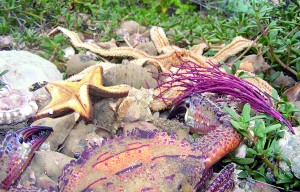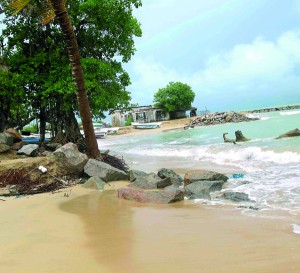Kalpitiya land grab for tourism
View(s):The people of Kalpitiya and its 14 islands have been battling – in collaboration with the National
Fisheries Solidarity Movement (NAFSO) and Praja Abhilasha Network (PAN) – against the prolific land grabbing taking place, according a report in a recent newsletter issues by the Law and Society Trust (LST).
The article titled “Tourism – Boom or Bane? Land Grabbing at Kalpitiya” says that residents of the area, almost all of who are fisher folks, have occupied these lands for the last 70–80 years.
“We have been living in this isle for generations and we are not prepared to give up our right to land even if we were given money in exchange,” says Sampath Pushpakumara, a resident of Mutwal in the Kalpitiya Peninsula.
“As Pushpakumara’s remark aptly expresses, loss of rights to these lands means that they are deprived of their ancestry, way of life, as well as their livelihoods and other income generating methods – and their future,” the LST report written by Herman Kumara from NAFSO says.
The Kalpitiya peninsula, located in the Puttalam district, is made up of 14 main islands. The 14 islands have a total landmass of 1672.67 hectares (4133.19 acres). Kalpitiya is home to 64,908 people (2009 Census) of which 12,967 are engaged in fisheries industry according to the UN Food and Agriculture Organisation (FAO).
The area is also one of the 15 sites for the country’s Tourism Development Strategy which was formulated as early as 2003. LST says that the acquisition of some 4000 acres of land for the project has begun as early as in 2004 pursuant to a Cabinet decision.
 Since 2003, around 1000 acres of lands which amounts to about 25 per cent of the Kalpitiya islands’ total land area have been grabbed in various ways and means from at least 2,500 families. Already 16 resorts or hotels and access roads are proposed for construction in the area.
Since 2003, around 1000 acres of lands which amounts to about 25 per cent of the Kalpitiya islands’ total land area have been grabbed in various ways and means from at least 2,500 families. Already 16 resorts or hotels and access roads are proposed for construction in the area.
Post-Tsunami (2005 onwards), those in the tourism business acquired damaged coastal areas at low prices around the country. Again in 2009, in the post-war period, investors in the tourism industry scrambled to ‘acquire’ potential business sites to capitalise on the reconstruction phase.
The LST report said that in addition, land seizures have also occurred by scrupulously removing the names of the residents from government documents such as the voters’ registry, abusing legal ownership regulations and stipulations of the government and ignoring
provisions in the customary law, using coercive means upon the residents who are unable to produce titles to the land they have been occupying and by taking over Beach Seine points and anchorage points by force.
Sri Lanka’s armed forces, state institutions such as the Board of Investment, Sri Lanka Tourist Board, and the Urban Development Authority, as well as the private investors engaged in tourism industry have so far been responsible for this wrongful mass scale land acquisitions, the report noted.
LST said affected residents have mobilized over several claims:
- Against the lack of transparency and duplicity in the state’s process of land acquisition. This is also reflected in the non-existence of consultative process in state decision-making with regard to the development projects and their benefits to the residents.
- Against loss of settlements, heritage and way of life which amounts to the deprivation of economic, social and cultural rights of the residents.
- Against loss of livelihoods for the majority of the population in Kalpitiya area, who are fisher folk and the loss of the richest fishing grounds in the country apart from the shortfall of around 250–400 metric tonnes of dry fish a year. This aspect should be compared with the profit made from the high end tourist industry and its potentiality to create employments for the residents in the area.
- Against the deliberate negligence on the part of the state on conservation of the fragile coastal ecosystem.
The sea erosion due to global warming and island’s erratic climate conditions will be aggravated by major scale construction projects. The existing mangroves will also be threatened in the process which in turn negatively affects the fisheries and sea food industry in the area.
- Against the violation of land tenure rights, customary rights and above all, the free, independent and peaceful life pattern of the island communities in Kalpitiya islands and the peninsula.
- Against the forceful land acquisition, violation of private ownership, and illegal land grabbing taking place in Kalpitiya area: which situation has been brought to the direct attention of President Mahinda Rajapaksa.
Follow @timesonlinelk
comments powered by Disqus


